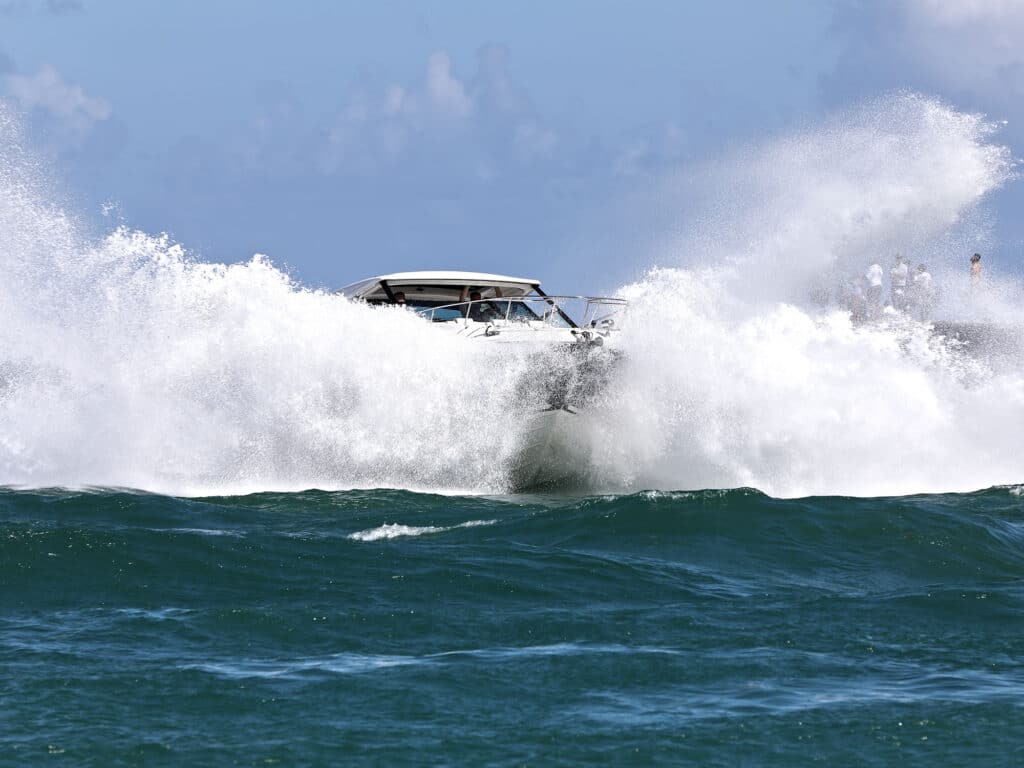
Seas grew mean as we neared the end of the 25-mile down-sea run while returning from Southern California’s Catalina Island and approached the entrance to San Pedro’s outer harbor aboard my 21-foot center-console.
Almost without warning, an immense and unavoidable trough loomed ahead as we crested the back side of a big roller. The boat plunged down the face of the wave and into the hole, burying the bow into the back of the wave ahead, shipping aboard an alarming amount of green water.
The precautions I had taken and my next moves would prove crucial in protecting the crew and saving the boat. Here are the lessons that can be learned from this experience.
Batten the Hatches
Most new boats today have hatches for the bilge and other deck compartments that can be sealed by dogging down a cam latch. Get in the habit of battening down a hatch whenever you close it, especially when you anticipate rough seas. This helps keep water from flooding below deck, where it’s more difficult and takes longer to drain from the boat. If a locker doesn’t have a means to batten it down, install a latch such as the Gemlux 2.5-inch-diameter stainless-steel cam latch. In addition, install a seal around the rim of the hatches using a product such as Taco Marine’s adhesive hatch tape.
Clear the Scuppers
Before you get underway, check the scuppers to make sure there’s nothing impeding their ability to bail the deck as quickly as possible. What might block a scupper? A towel or a fishing rag might do it, and so will a discarded plastic grocery bag, a wad of dead baitfish or chunks of chum. Or perhaps someone’s beanbag chair might block a deck scupper. Whatever it is, clear it out to ensure your self-bailing deck can do its job.
Ensure a Working Bilge Pump
Prudent seamanship dictates that you check not just the bilge pump before every trip, but also the auto function. First, flip on the manual switch and listen for the whir of the bilge-pump motor. Then go back and activate the automatic switch to make sure the pump turns on. While you’re down in the bilge, check for debris that might clog or block the strainer and prevent it from picking up water. Never go to sea without a properly functioning bilge-pump system, as this might well be the key to keeping your crew and your boat afloat if water makes its way below deck.
Slow Down, But Don’t Stop
In the case of stuffing the bow as I did, there was a temptation to stop and assess the situation. But that would have allowed the ankle-deep water to slosh about and possibly throw the boat off-balance if all the water sloshed to one side. Instead, I pulled back the throttle to help prevent taking on more water over the bow. At the same time, I kept the boat moving ahead with enough speed to keep following seas from coming over the transom. This kept the water concentrated in the aft cockpit, forcing it out through the scuppers, draining the deck.
Keep the Crew in Position
As much as crewmembers want to help in such situations, it is often best they remain in position, especially with water sloshing around. The additional weight of a crewmember or two on the side of the boat combined with water rushing to the same side can cause the boat to heel over and dip the gunwale, allowing waves to crest the side. Better to have crew stay still along the centerline.
Read Next: Hand-Held Bilge Pumps
Wait for the Deck to Clear
Once the deck and bilge compartments are clear of water, you can make speed again. In my case, however, I slowed the pace to keep from outrunning the waves and plunging into another hole. At the same time, I trimmed up the outboard to keep the bow as high as possible to avoid shipping seas a second time in the rough water.
Don’t Panic
Panic only makes things worse, but avoiding it can be easier said than done. Having a plan mapped out ahead of time, as I did, helps you focus immediately on the solution rather than fret over the precarious situation. Sharing the contingency plan with the crew in advance of a potential emergency can help prevent them from panicking as well. Sure, your adrenaline will be up, but you can put that energy to good use in swiftly bailing a sea as long as you have a plan.









